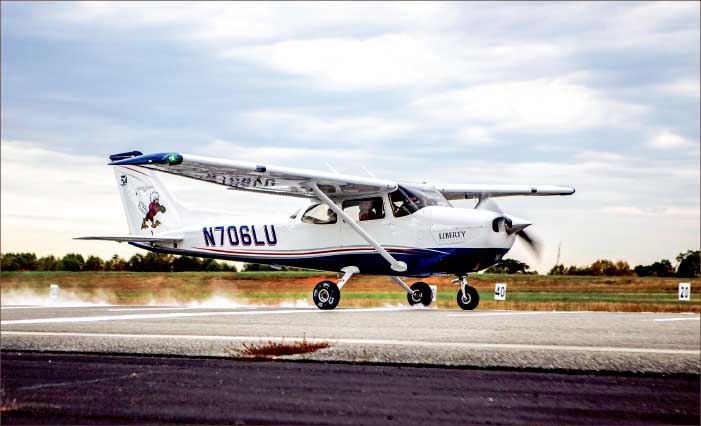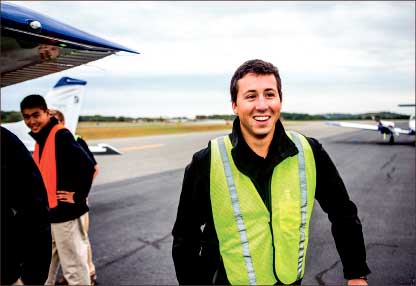Victory for Aeronautics

Liberty’s flight team wins the Region 10 NIFA competition for the 11th year

Take to the skies — Flight team members competed in three days of events at the Lynchburg Regional Airport Oct. 15-17 for an intercollegiate competition. Photo credit: Michela Diddle
Dressed in formal attire with ice cream in hand, the Liberty University School of Aeronautics flight team shared stories and smiles after the award banquet Oct. 17.
For the 15-person flight team, a trip to an ice cream shop is a tradition that always follows after a victory — the 11th year in a row of winning the Region 10 National Intercollegiate Flight Association (NIFA) competition was of no exception.
NIFA competitions are held at the national level, but the competitors must first qualify in regionals. The NIFA organization was formed in 1920 with four events and nine schools competing. These schools included Yale and Wesleyan, according to the NIFA website.
The makings of the Loening Trophy, still awarded today, according to the “SAFECON Leoning Trophy Judging Criteria” document on NIFA’s website, identify the prestige of this award.
“The Loening Trophy is the rarest and oldest of all collegiate aviation awards,” the document reads. “The pure silver Tiffany designed trophy was commissioned and first awarded in 1929 when aviation pioneer and inventor, Dr. Grover Loening saw a need to annually recognize the most outstanding achievements of today’s college aviation programs.”
To emphasive the credibility of the award, the document also states “Dr. Loening (first aeronautical engineer for the Wright Brothers), asked his friends … Charles Lindbergh, Amelia Erhart, and Navy Commander John Towers to assist him in judging the first competition.”
Liberty hosted the competition at the Lynchburg Regional Airport Oct. 15-17 against the United States Naval Academy, Averett University, and Guilford Technical Community College and walked away with first place in the ground, flight and overall competition categories.
The three-day competition focused on ground events such as simulated comprehensive aircraft navigation (SCAN) — “a written exam with problems that reference a simulated cross country flight over a given route,” according to the program given at the awards banquet.

Score — Liberty’s flight captain Evan Thrams smiles at his power-off landing results. Photo credit: Michela Diddle
“(The competition is) like taking an SAT for aviation,” Imani Nasir-Phillips, Guilford’s team captain, said.
Other ground events included a computer accuracy test, aircraft preflight — an aircraft is purposefully “bugged” and technicians identify problems with the plane — and the ground trainer test to “test the competency and skill” under certain flight rules in an aircraft simulator, according to the program.
Another ground event involved competitors looking at a picture of an airplane for three seconds and then having 15 seconds to note the aircraft’s manufacturer, model number and common name, according to the bulletin. Edward Hubbart of Guilford took first with a rare score of 89/100 for the regional competition, more than 20 points ahead of second place.
“I’ve been building models since I was 14,” Hubbart said to the evening’s announcer and chief judge of the competition, Brian Hough.
During the ground events, other flight events continued near the hangar and the landing strip.
Flight events included short field landing — where pilots must land on a thick chalk line on the runway or as close to that line as possible. Power-off landing, similar to short-field, required pilots to land without power from the engine in order to simulate engine failure, the goal being a successful landing. Some of the competitors actually scored a perfect landing, an accomplishment somewhat rare at the regional level.
The final student flight event, the message drop, finished up the official NIFA competition Saturday morning as pilots flew 200 feet above ground and drop masters aimed for a target below with a specially made box containing a message that could weigh no more than 2.5 ounces and had to meet specific requirements for design.
For Liberty’s team, the Liberty School of Engineering and Computational Sciences used their 3D printer to make a box fitting the bill for the flight team.
In addition to the exclusively ground and flight events, the “navigation” event combined the two categories. This event was comprised of a two-person pilot/navigator team giving the judges a precise flight plan including fuel needed, total time and other specifics as well as participating in a cross-country flight based off the flight plan, according to the program.
The last event of the competition involved not the students, but the coaches flying and landing.
Even though Liberty would have the home team advantage for running the flight patterns, each team received about five to six hours of practice time before the competition, according to Liberty’s new head coach, Tony Cihak, who took third in the coach’s competition. The teams intermingle with a sense of rivalry, but the Liberty competitors also shared information about the course to help the other teams.
“We try to make it an even competition … (so the) best pilot wins,” Cihak said.
Liberty did have the advantage of provision from the school, according to flight team captain Evan Thrams, who placed in multiple events such as power-off landing, aircraft recognition, SCAN, and short-field landing.
“A lot of these teams don’t have any school support, whereas we are fully supported and funded by the school of aeronautics at Liberty which is an amazing blessing,” Thrams said.
And for the Navy team, who took third overall, practice time is something they do not see during a regular schedule, so the opportunity to fly and prepare before the competition proved helpful, according to their advisor, Commander Dave Hauth. Hauth, who received second in the coach’s landing event and the award for coach/advisor of the year at the regional level, said most of the team takes about 22 credit hours as engineers, but the GPA average still stays around 3.8. On top of their rigorous academic schedule and naval training, the team still manages to compete for NIFA.
“Our stated goal was to do better than last year,” Hauth said.
And the team did, along with the other teams.
Even though the competition involved a lesser number of teams than past years, the scores were higher this year than last, according to Hauth.
“We were looking at last years scores, and last years (individual event) winners would not have finished in the top five,” Hauth said.
For senior Sean Cothran, he verified that this statement rang true for Liberty’s team.
“Two years ago, we got more awards (at the regional level) than (we had) ever gotten, but this year the skill level is higher,” Cothran said.
Even though Cothran did not compete because of a complication with an Air Force Reserve Officer’s Training Corps (ROTC) commissioning service during the nationals competition in May, he oversaw the cornhole tournament which he won alongside his teammate Deanna Ludwig, and he reminisced of Liberty’s win two years ago.
In 2014, Liberty competed in the NIFA SAFECON and accomplished a fifth overall ranking, higher than big name schools such as the United States Air Force Academy and Embry-Riddle Aeronautical University of Daytona, according to the official competition results website.
Cothran is the only remaining team member from that year and compared this year’s team to the team of 2014.
Considering Cothran cannot compete with the team at nationals, he wished them the best, but he hoped they will continue to excel for reasons higher than just a title on a resume.
With competing in the NIFA competitions, Liberty’s team has the opportunity to interact with pilots all over the nation and share this message, and Bob Hudson, associate dean of flight operations, who placed first in the coach’s landing, echoed this thought.
“We want our team to be really good at what they do so people will pay attention to what they have to say,” Hudson said. “That just provides a spring board to show (our) faith and why (we) believe it.”
At the end of Saturday night, outside of Cold Stone Creamery, after the ice cream, socialization, and congratulations to teammates, Cihak brought the competitors together for a team prayer — to credit God for the victory, another tradition within the team’s history.
The Liberty team will continue to the national competition in May.
TILLER is the feature editor.
